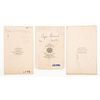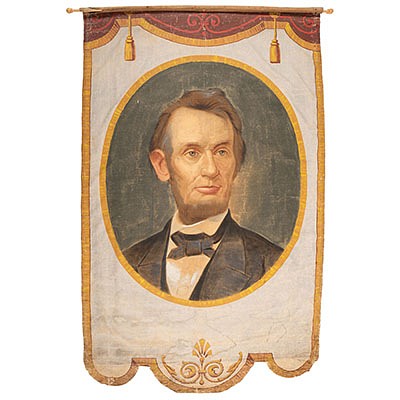[CIVIL WAR]. A group of 3 CDVs of identified US Navy officers, incl. C.R. Perry Rodgers, A.M. Pennock, and S.W. Mather, KIA Mosquito Inlet, FL.
About Seller
6270 Este Ave.
Cincinnati , OH 45232
United States
With offices in Cincinnati, Cleveland and Denver, Cowan’s holds over 40 auctions each year, with annual sales exceeding $16M. We reach buyers around the globe, and take pride in our reputation for integrity, customer service and great results. A full-service house, Cowan’s Auctions specializes in Am...Read more
Two ways to bid:
- Leave a max absentee bid and the platform will bid on your behalf up to your maximum bid during the live auction.
- Bid live during the auction and your bids will be submitted real-time to the auctioneer.
Bid Increments
| Price | Bid Increment |
|---|---|
| $0 | $25 |
| $500 | $50 |
| $1,000 | $100 |
| $2,000 | $250 |
| $5,000 | $500 |
| $10,000 | $1,000 |
| $20,000 | $2,500 |
| $50,000 | $5,000 |
| $100,000 | $10,000 |
About Auction
Jun 25, 2021
The June 25 American Historical Ephemera and Photography Auction features an exciting assemblage of 18th-early 20th century material, including Civil War archives, Early Photography, Western Americana, Autographs and Manuscripts, and more. Cowan's Auctions dawnie@cowans.com
- Lot Description
CDV, period copy of a Mathew Brady view identified in pencil as "Capt. CRP Rogers" on verso. (Excellent, strong corners.) Factually, this is illustrious 'old navy' officer C.R. Perry Rodgers who entered as Midshipman, 10/5/33; Passed Midshipman,7/8/39; Lieutenant. 9/4/44; Commander, 11/15/61; Captain, 7/25/66; Commodore, 8/28/70; Rear-Admiral, 6/14/74; Retired List, 11/14/81, Died 1/8/92. With the advent of war, Rodgers was serving as Commandant of Midshipmen at the Naval Academy and oversaw its relocation to Newport, RI for the duration. He then took command of the steam frigate Wabash, flagship of the South Atlantic Blockading Squadron, and would distinguish himself at the Battle of Port Royal on November 7, 1861 which was recognized by an immediate promotion to commander. Rodgers saw more action during the capture of Fort Pulaski in April 1862 before assuming command of the recently commissioned broadside ironclad USS New Ironsides at Charleston in 1863. Admiral DuPont noted, "No language could overstate his services to his country and to myself." Arguably, Admiral Rodgers' most significant career achievement occurred while serving as Commandant of the Naval Academy from September 1874 through July 1878. As the navy declined in the post-war years reflecting an institutional retrograde to a benign "sailing ships and smoothbore cannon" mentality, Rodgers revamped and upgraded the Academy's curriculum studied by the future officer corps. The emphasis shifted to upper level engineering and first ever mechanical engineering courses. First and second year classmen were now exposed to advanced mathematics, mechanics, physics, and chemistry subjects rather than strictly rote memorization of navy tradition and dogma. The shift in emphasis would have a profound impact on the future officer corps and "laid the groundwork for an American naval renaissance in the 1880s."
[With:]
CDV, full standing portrait copy shot identified twice on verso as "Capt. Pennock." New York: Anthony, [1860s]. (Light, albumen separated from the mount nearly 2/3 from the bottom, bottom corners clipped, good.) Alexander Mosley Pennock (1814-1876) was another 'old salt' who joined as Midshipman, 4/1/28; Passed Midshipman, 6/14/34; Lieutenant, 2/25/41; Commander, 12/15/55; Captain, 1/2/63; Commodore, 5/6/68; Rear-Admiral, 7/19/72; Died 9/20/76. In January 1862 Commander Pennock assumed command of the fledgling navy base at Cairo, Illinois and oversaw the construction/conversion of dozens of Brown Water Navy warships while managing both base and fleet logistics. Additionally, in September 1862 he took command of the Upper River Flotilla which patrolled the wide ranges of the Cumberland, Tennessee, and Ohio Rivers for the duration of the war. Captain Pennock's zeal and diligence earned him "a reputation as one of the best wartime executives of the navy." The crowning achievement was promotion to rear-admiral in 1872.
[With:]
CDV, officer vignette reflecting the rank of master, autographed in heavy ink, "Yours truly / S.W. Mather." 165 Eight Ave.: Young &. Co., [1860s]. (Very good with strong tones, bold signature, minor edge wear along mount.) S.W. Mather became Acting Master 5/17/61 and was Killed in Action 3/22/62 at Mosquito Inlet (Lagoon), Fla. This obscure riverine action was a reconnaissance undertaken by US Gunboats Penguin and Henry Andrews, Mather's ship. The Union crews were carried up the St. Johns River in five boats containing 43 men. In the confines of narrow water the caravan was ambushed by local Southern irregulars, the violence resulting in 8 killed including Mather, 8 more wounded, and 3 captured including the African American pilot - name never known - who was later hung by the same group of partisans. A compelling account of the ambush, Mather's instant death, and atrocity committed on the pilot is found in Bluejackets and Contrabands: African Americans and the Union Navy, 2009 (pp.183-185).
The Richard B. Cohen Civil War Collection Lots 79-98; 116; 138-153; and 266
Cowan's is pleased to offer the third installment of Richard B. Cohen's collection of Civil War Brown Water Navy photography. Richard was known to many in the field as a "disciplined collector who maintained a relatively narrow focus having built an important, perhaps unsurpassed collection in his area of specialization." From cartes de visite to large format photographs, this portion of the collection features a noteworthy selection of images of Brown Water Navy warships, among them, the USS Benton, Choctaw, Lafayette, and Louisville. Many important identified naval officers are also represented, including an exquisite CDV of the promising young officer, Lieutenant Commander William Gwin, who died of wounds aboard the USS Benton following an artillery duel with Confederate forces at Snyder's Bluff, and an exceptionally large war-date photograph of the controversial commander of the USS Pittsburgh, Egbert Thompson.
This auction also features a premiere selection of autographs and manuscripts from Richard's carefully curated collection. Highlights include a letter from Jefferson Davis to his distant cousin, John J. Pettus, Governor of Mississippi, dated a year before secession, conveying intricate plans for securing armaments in preparation for the war; an Abraham Lincoln signed endorsement; a letter from Admiral D.G. Farragut from New Orleans, offering excellent insight into his "political" thinking as well as his dedication to his work; correspondence from Gideon Welles, David Dixon Porter, U.S. Grant, and W.T. Sherman; and a pair of superb letters with highly descriptive accounts of the Battle of the Monitor and Merrimac.
Provenance: The Richard B. Cohen Civil War Collection - Shipping Info
-
SHIPPING & PICKUPS Cowan’s Cincinnati Office offers an in-house, full-service shipping department which is unparalleled in the auction industry. Shipping costs are provided with your finalized invoice 24-48 hours after auction. For furniture and oversized items, we recommend using third-party services. For more information, contact cowansshipping@hindmanauctions.com. NOTE: All pickups and preview are by appointment only. To make an appointment, please call 513-871-1670 or email cincinnati@hindmanauctions.com Buyers are required to pay for all packing, shipping and insurance charges. Overseas duty charges are the responsibility of the successful Bidder. Be aware that for larger and/or valuable items, shipping charges can be substantial. - Shipping charges include insurance for your order while in transit. If you have private insurance we will adjust your charge to include only packing and shipping. - Please allow 14 – 21 days after payment to package and ship your purchase as carefully as possible.
-
- Buyer's Premium



 EUR
EUR CAD
CAD AUD
AUD GBP
GBP MXN
MXN HKD
HKD CNY
CNY MYR
MYR SEK
SEK SGD
SGD CHF
CHF THB
THB![[CIVIL WAR]. A group of 3 CDVs of identified US Navy officers, incl. C.R. Perry Rodgers, A.M. Pennock, and S.W. Mather, KIA Mosquito Inlet, FL.](https://s1.img.bidsquare.com/item/l/8589/8589653.jpeg?t=1LMY29)
![[CIVIL WAR]. A group of 3 CDVs of identified US Navy officers, incl. C.R. Perry Rodgers, A.M. Pennock, and S.W. Mather, KIA Mosquito Inlet, FL.](https://s1.img.bidsquare.com/item/s/8589/8589653.jpeg?t=1LMY29)











